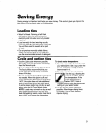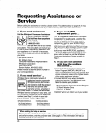
Saving Energy
Saving energy is important and helps you save money. This section gives you tips on the
best ways to save energy with your dishwasher.
Loading tips
l Wash full loads. Running a half-filled
dishwasher uses the same amount of
electricity and hot water as a fully loaded
machine.
l Load correctly for best washing results.
Incorrect loading may cause poor washing.
You will then need to rewash all or part
of load.
l Do not prerinse normally soiled dishes.
Select the correct cycle for the load and
use the recommended amount of detergent.
Cycle and option tips
l Use the Light cycle whenever possible.
The cycle uses less hot water and energy
than the Normal cycle.
l Run your dishwasher during off-peak hours.
The local utilities recommend that you
avoid using too much energy at certain
times of the day.
l Do not use the Hi-Temp Wash option if it is
not needed. When this option is off and
water entering the dishwasher is lower than
14O”F, the cycle does not take additional
time to heat water during the main wash.
In some cases, loads may not dry as well
when using the Hi-Temp Wash option.
NOTE: Loads may not wash or dry as well
if the water temperature is too low. For
best dishwashing results, water must be at
least 120°F as it enters the dishwasher.
To check water temperature:
1. Run hot water at the faucet closest to
your dishwasher. Set a cup under the
faucet, and place a candy or meat
thermometer in it.
2. Run hot water for at least 1 minute
L!zl
into the cup, allowing the
water to overflow. Check
the temperature. If the
water temperature is
below 12O”F, have a
qualified person raise the thermostat
setting on your water heater.
l Use the Air Dry option whenever
possible. Allow longer drying times
(overnight). Use a rinse agent to
improve drying.
21


















